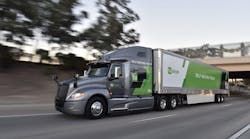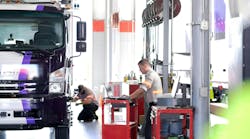TuSimple has developed a proprietary automotive-grade camera and vision system that will go into volume production in Q2 2019 and will be deployed on TuSimple’s autonomous customer fleet by Q3 2019. As the company’s entry into hardware design, the system offers enhanced reliability of autonomous operation and is a necessary step in the company’s quest to commercialize the first driverless truck.
The custom designed camera system allows for reliable night and low light autonomous operation, more than doubling its current truck utilization rates to 20 hours a day.
TuSimple plans to increase its U.S. fleet to 50 trucks by June, with more to follow. This camera system designed for the company’s fully-autonomous Level 4 trucks is an important component of TuSimple’s ability to scale, especially as the company moves beyond its validation phase.
“Bringing reliable nighttime and low light operation to the current perception system in the market is an important step in the viability of autonomous driving, which is a strategic focus for us,” said Tsutomu Haruta, automotive business division deputy SGM, Sony Semiconductor Solutions Corporation. “We’re pleased that TuSimple, the leading self-driving truck company appreciates the cutting-edge technology that Sony is known for.”
TuSimple has leveraged Sony Semiconductor Solutions Corporation’s automotive CMOS image sensor to create a set of camera systems for short, medium and long range that use TuSimple’s software to detect and process sharp images in real-time as far as 1,000 meters away. The system addresses complex imaging challenges such as instant light changes when entering and exiting tunnels, flaring during sunrise and sunset, and headlight glare. It also handles the LED flicker created by digital signage and traffic lights.
“Like human drivers, autonomous trucks’ perception systems are challenged by a wide variety of light conditions which are experienced every day while driving. We weren’t able to find a camera system on the market that fit our needs, so we created one,” said Dr. Xiaodi Hou, founder, president and chief technology officer, TuSimple. “The combined expertise of Sony Semiconductor Solutions Corporation and TuSimple has created a perception system that sees better than human eye – night and day, rain or shine — in the most challenging driving conditions.”
This new camera system is designed to Automotive Safety Integrity Level (ASIL)-C, which is important for the validation of safety-related electronic systems that must be highly reliable in specific driving conditions as outlined in the ISO 26262 Functional Safety standard. As the system integrator, Sunny Optics will test the product and module, as well as develop and manufacture the automotive-grade product.
With $95 million USD in new funding and daily autonomous trips hauling freight, the company is on its way to achieving its milestone of first driverless operations by the end of 2020 and delivering on its goal to create a safer, cleaner, and more efficient trucking industry.



